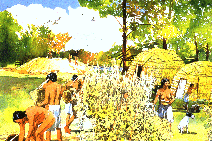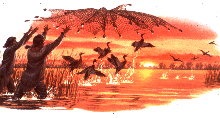
| Environment | Technology | Settlement | Economy | Society | Health | Religion | |
| How-Do-We-Know? | |||||||
| Paleo-Indian | Archaic | Woodland | Mississippian | European Contact |


Squash was a major cultigen. Through generations of gathering certain seed-bearing plants came to be domesticated. Cultivated plants include maygrass, marshelder, little barley, and possibly lambsquarter and knotweed. However, wild plants and animals remained as important dietary staples for Woodland people.
By cultivating plants, early gardeners changed forever their relationship with the land. They had a more stable food source to carry them through winter and to provide seed for spring planting. Equally important was the intensified use of plentiful and easily attained aquatic resources, particularly fish. The large food storage pits found from sites dating to the end of this period indicate that these people were increasingly able to build food surpluses. By the end of the Woodland period, corn was ended to the list of cultigens.
Through the Woodland period, Native Americans in the region had a greater impact on their environment than did the previous inhabitants. More permanent settlements required more wood for fuel and home construction and land had to be cleared for gardens

| Paleo-Indian | Archaic | Woodland | Mississippian | European Contact |